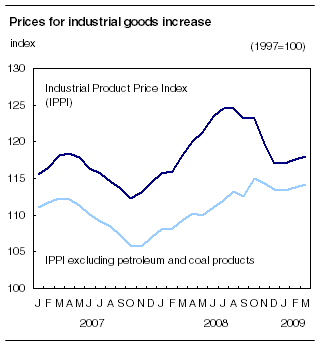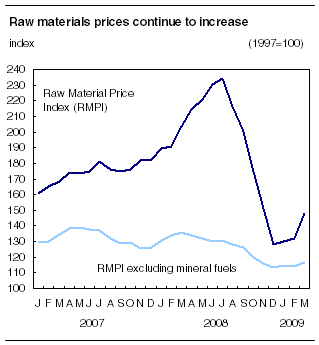Common menu bar links
Industrial product and raw materials price indexes
The Industrial Product Price Index (IPPI) rose 0.3% in March compared with February, due to the depreciation of the Canadian dollar against the US dollar and higher prices for primary metals. The Raw Materials Price Index (RMPI) advanced 12.1% compared with February, pushed up by a strong increase in crude oil prices.

The IPPI rose 0.3% in March following a 0.5% increase in February.
Motor vehicles and other transport equipment rose 0.9%, as a result of the depreciation of the Canadian dollar in relation to its US counterpart. Prices for primary metal products increased 1.3%, pushed up by copper and copper alloys in primary forms. These increases were offset in part by lower prices for metal fabricated products, petroleum and coal products as well as chemical products.
The Canadian dollar lost 1.5% of its value against the US dollar in March. Some Canadian producers who export their products to the United States are paid in prices set in US dollars. Consequently, the relative strength of the US dollar in relation to the Canadian dollar had the effect of inflating the corresponding prices in Canadian dollars. If the exchange rate used to convert these prices had remained unchanged, the IPPI would have declined 0.1% instead of rising 0.3%.
Note to readers
The Industrial Product Price Index (IPPI) reflects the prices that producers in Canada receive as the goods leave the plant gate. It does not reflect what the consumer pays. Unlike the Consumer Price Index, the IPPI excludes indirect taxes and all the costs that occur between the time a good leaves the plant and the time the final user takes possession of it, including the transportation, wholesale, and retail costs.
Canadian producers export many goods. They often quote their prices in foreign currencies, particularly for motor vehicles, pulp and paper products, and wood products. Determining the full effect of fluctuating exchange rates on the IPPI is a difficult analytical task. However, it should be noted that many prices collected to calculate the IPPI are quoted in US dollars and then converted into Canadian dollars. Therefore, a rise or fall in the value of the Canadian dollar against its US counterpart affects the IPPI.
The conversion of prices received in US dollars is based on the average monthly exchange rate (noon spot rate) established by the Bank of Canada, and it is available on CANSIM in table 176-0064 (series v37426). Monthly and annual variations in the exchange rate, as described in the text, are calculated according to the indirect quotation of the exchange rate (for example, CAN$=US$X).
The Raw Materials Price Index (RMPI) reflects the prices paid by Canadian manufacturers for key raw materials. Many of these prices are set in a world market. Unlike the IPPI, the RMPI includes goods not produced in Canada.
12-month change: Slight decline of the IPPI
The IPPI edged down 0.1% in March compared with the same month a year earlier, marking a change in direction compared with the increases observed in the previous 11 months.
The effect on the IPPI of lower prices for petroleum and coal products and primary metal products was offset in part by higher prices for motor vehicles and other transport equipment, pulp and paper products, machinery and equipment, and electrical and communication products.
On a 12-month basis, prices for petroleum and coal products fell 33.4%, compared with the drop of 27.8% in February. Prices for products excluding petroleum and coal products rose 4.5%, down from the 5.2% increase recorded in February.
The Canadian dollar has lost 20.8% of its value since March 2008, and if the direct effect of the exchange rate had been excluded, the IPPI would have declined 6.8% instead of 0.1%.
Raw Materials Price Index: Strong increase for crude oil in March
The RMPI registered a month-over-month increase of 12.1% in March, up from the growth rates of 1.5% in January and 1.6% in February. Almost all the growth in March was attributable to mineral fuels.

Mineral fuels rose 25.9% in March and crude oil, the main component of this group, increased 33.1%. The last time crude oil recorded a comparable month-over-month increase was in September 1990 when it advanced 29.5%. Nevertheless, the crude oil index is still down 56.3% from its all-time high reached in July 2008. Excluding mineral fuels, the RMPI increased 2.5%, following a 0.4% decline in February. The strongest increases were for non-ferrous metals, animals and animal products and vegetable products.
From March 2008 to March 2009, raw material prices fell 27.2%, comparable to the changes recorded since December 2008. The year-over-year drop in raw material prices was attributable to the strong 38.5% decline for mineral fuels and, to a lesser extent, to decreases in the prices for non-ferrous metals (-36.0%) and vegetable products (-20.1%).
Available on CANSIM: tables 329-0038 to 329-0049 and 330-0006.
Definitions, data sources and methods: survey numbers, including related surveys, 2306 and 2318.
The March 2009 issue of Industry Price Indexes (62-011-XWE, free) will soon be available.
The Industrial product and raw material price indexes for April will be released on June 1.
For more information, or to enquire about the concepts, methods or data quality of this release, contact Client Services (toll-free 1-866-230-2248; 613-951-9606; fax: 613-951-2848; prices-prix@statcan.gc.ca), Producer Prices Division.
Table 1
| Relative importance | March 2008 | February 2009r | March 2009p | March 2008 to March 2009 | February to March 2009 | |
|---|---|---|---|---|---|---|
| (1997=100) | % change | |||||
| Industrial Product Price Index (IPPI) | 100.00 | 118.1 | 117.6 | 118.0 | -0.1 | 0.3 |
| IPPI excluding petroleum and coal products | 94.32 | 109.3 | 113.8 | 114.2 | 4.5 | 0.4 |
| Aggregation by commodities | ||||||
| Meat, fish and dairy products | 5.78 | 109.2 | 113.1 | 113.8 | 4.2 | 0.6 |
| Fruit, vegetables, feeds and other food products | 5.99 | 118.0 | 116.4 | 116.9 | -0.9 | 0.4 |
| Beverages | 1.57 | 126.2 | 128.8 | 128.8 | 2.1 | 0.0 |
| Tobacco and tobacco products | 0.63 | 218.2 | 223.6 | 223.6 | 2.5 | 0.0 |
| Rubber, leather and plastic fabricated products | 3.30 | 115.9 | 121.7 | 122.0 | 5.3 | 0.2 |
| Textile products | 1.58 | 99.8 | 103.2 | 103.2 | 3.4 | 0.0 |
| Knitted products and clothing | 1.51 | 104.8 | 104.7 | 104.8 | 0.0 | 0.1 |
| Lumber and other wood products | 6.30 | 80.3 | 83.2 | 83.3 | 3.7 | 0.1 |
| Furniture and fixtures | 1.59 | 121.2 | 124.1 | 124.1 | 2.4 | 0.0 |
| Pulp and paper products | 7.23 | 103.8 | 116.2 | 116.6 | 12.3 | 0.3 |
| Printing and publishing | 1.70 | 115.8 | 126.1 | 126.0 | 8.8 | -0.1 |
| Primary metal products | 7.80 | 149.8 | 123.3 | 124.9 | -16.6 | 1.3 |
| Metal fabricated products | 4.11 | 126.6 | 136.7 | 135.6 | 7.1 | -0.8 |
| Machinery and equipment | 5.48 | 104.1 | 113.3 | 113.8 | 9.3 | 0.4 |
| Motor vehicles and other transport equipment | 22.16 | 86.2 | 100.3 | 101.2 | 17.4 | 0.9 |
| Electrical and communications products | 5.77 | 89.4 | 98.0 | 98.3 | 10.0 | 0.3 |
| Non-metallic mineral products | 1.98 | 124.2 | 129.1 | 129.0 | 3.9 | -0.1 |
| Petroleum and coal products1 | 5.68 | 281.2 | 187.9 | 187.4 | -33.4 | -0.3 |
| Chemicals and chemical products | 7.07 | 132.5 | 133.8 | 133.3 | 0.6 | -0.4 |
| Miscellaneous manufactured products | 2.40 | 119.0 | 127.1 | 127.5 | 7.1 | 0.3 |
| Miscellaneous non-manufactured products | 0.38 | 353.9 | 268.0 | 254.9 | -28.0 | -4.9 |
| Intermediate goods2 | 60.14 | 124.5 | 120.1 | 120.2 | -3.5 | 0.1 |
| First-stage intermediate goods3 | 7.71 | 156.3 | 121.4 | 120.8 | -22.7 | -0.5 |
| Second-stage intermediate goods4 | 52.43 | 119.8 | 119.9 | 120.1 | 0.3 | 0.2 |
| Finished goods5 | 39.86 | 108.6 | 114.0 | 114.8 | 5.7 | 0.7 |
| Finished foods and feeds | 8.50 | 116.9 | 120.0 | 120.5 | 3.1 | 0.4 |
| Capital equipment | 11.73 | 95.8 | 107.7 | 108.4 | 13.2 | 0.6 |
| All other finished goods | 19.63 | 112.7 | 115.2 | 116.1 | 3.0 | 0.8 |
Table 2
| Relative importance | March 2008 | February 2009r | March 2009p | March 2008 to March 2009 | February to March 2009 | |
|---|---|---|---|---|---|---|
| (1997=100) | % change | |||||
| Raw Materials Price Index (RMPI) | 100.00 | 203.7 | 132.2 | 148.2 | -27.2 | 12.1 |
| Mineral fuels | 35.16 | 350.8 | 171.4 | 215.8 | -38.5 | 25.9 |
| Vegetable products | 10.28 | 142.1 | 112.1 | 113.6 | -20.1 | 1.3 |
| Animals and animal products | 20.30 | 104.1 | 110.7 | 114.8 | 10.3 | 3.7 |
| Wood | 15.60 | 81.4 | 79.3 | 78.7 | -3.3 | -0.8 |
| Ferrous materials | 3.36 | 153.6 | 148.2 | 149.4 | -2.7 | 0.8 |
| Non-ferrous metals | 12.93 | 226.6 | 138.3 | 145.0 | -36.0 | 4.8 |
| Non-metallic minerals | 2.38 | 162.6 | 177.4 | 177.4 | 9.1 | 0.0 |
| RMPI excluding mineral fuels | 64.84 | 135.7 | 114.1 | 116.9 | -13.9 | 2.5 |
